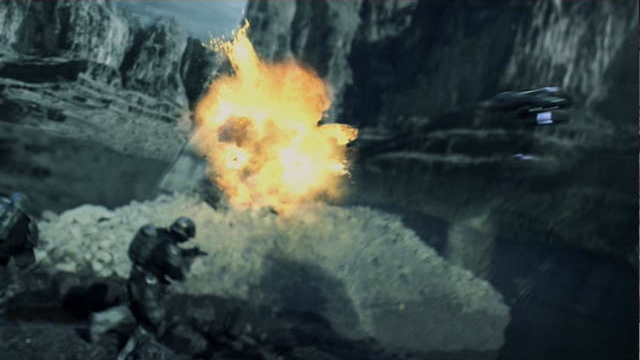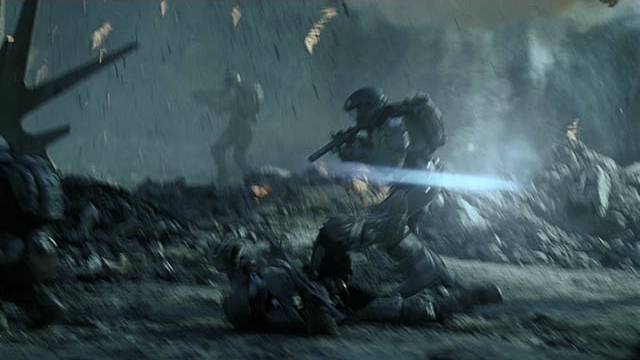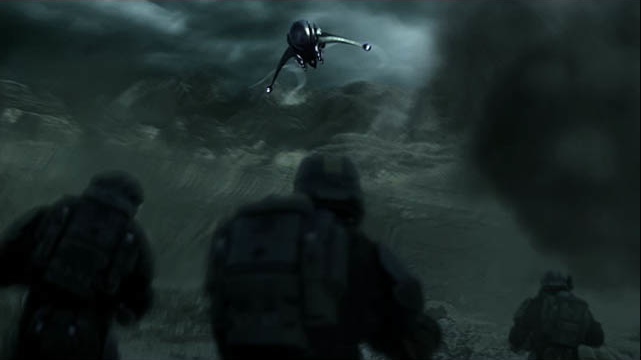The Life, a live action short directed by MJZ’s Rupert Sanders to promote the launch of Halo 3: ODST for the Xbox 360, features visual effects by Asylum as we follow Tarkov, an Orbital Drop Shock Trooper, through training and a major battle sequence. Visual effects supervisor and lead compositor Rob Moggach tells fxguide how Asylum added elements and grit to the live action.
View a QuickTime movie of the completed spot.
Moggach: We had to add in a bunch of unseen visual effects, clean-up work, compositional changes and natural elements. Through the battle sequence we did lasers, interactive lighting, visors and visor reflections, CG spaceships, muzzle flashes, matte paintings for the background, atmospheric smoke and haze and sky replacements.
We also did some explosion enhancements, although most of these were in-camera. Generally we added effects to make it impressive without it feeling it too cinematic. Rupert was very much about keeping things natural and believable, but at the same time he’s a very strong visualist. We had two and half weeks from 2K plates to finish this two and half minute film, which was originally meant to be a 60 second spot. We doubled and tripled our crew in the days leading up to it so we could get it done.
fxg: Can you take me through some of your work for the opening funeral shots?
Moggach: For the first wide shot, they had about a third of the tombstones with the fires on them. We were tasked with repeating those all the way around. Most of it is in-camera, but we did do some clean-up on the background just to remove some windows. The next shot involved putting fires in all those tombstones.
We made the grave a little bit bigger and added some foreground tombstones. We also did some selected colour correction on the talent to make them stand out more. The plates were shot in a working powerplant in Hungary. It’s one of those cooling towers that you attribute to a nuclear power plant but this was a coal-fired plant. We were shooting inside a cooling tower in 45 degree heat.
fxg: How did the battle sequence come together?
Moggach: That was shot in an open pit coal mine where they actually mine the coal for the power plant. We spent two days there. It was the middle of summer in Hungary, with no wind because we were in the pit and giant machines all around us because it’s a working coal mine. It was a really gritty atmosphere. A lot of the grit you see in the film comes from the actual locations. It was a great experience – not sure I’d want to do it again – but I’ll never forget it.
The first couple of shots are full CG backgrounds. The background mountains, lasers, muzzle flashes and spaceships are all CG. Almost all of the explosions are in-camera. We did add some of the trademark Halo plasma when things explode. Because we were working on flat plates, we had to do a lot of work to match what had been set as the overall colour mood. We had an interesting workflow in Flame 2009 using the new floating point tools to bring our flat log plates into the same colour world.
fxg: What were some of the tools you used for the CG work?
Moggach: Some of the impact work was done in Houdini, all the animation was done in Maya and rendering was a combination of RenderMan and Mantra. I’ll do pre-comps in Nuke and finishing in Flame. So a lot of times it was a multi-step process where I’d pre-comp my CG in Nuke in floating point in linear space and then bring it over for final finishing and ‘grit’ in Flame. Tracking was all SynthEyes and rotoing was done in Silhouette.
Moggach: It was. I think this is a perfect example of not finding any clever solutions to problems, but rolling up your sleeves and getting it done. I call it brute force visual effects. Even just the compositing, there were no special workarounds. We just had to put the pieces together and keeping fighting with the Flame until it gets there.
For the transitions, from the beginning to the training and to the end funeral, we matched the camera move through the cut so that it felt a little more fluid. Matching the eyes, matching the camera motion, matching the sides of the face so that you get a sense of following this guy through his life, that it’s the same guy, despite it being different actors.
fxg: I was thinking the visors would also involve that kind of brute force work?
Moggach: They were interesting, because we didn’t want to get into masked environments for every shot and doing 3D tracks and getting CG artists to render things, so what I did was I had the CG artists track the visors for each shot and then give that to the Flame. That way we could interactively put in elements that would work and map them in 3D.
We basically did all the 3D visors in the Flame. It made the process a lot faster and more interactive because we’d get to see the results a lot more quickly. Because the shots are so frenetic and shaky, it’s only one or two frames you need to see something, like a bright flash or explosion in the visor. It would’ve taken so long to animate that in CG, whereas if we had the footage on hand it was just a matter of bashing it into the visor as a reflection map in Flame, and twisting it around until it looks right.
fxg: How did you accomplish the laser trails?
Moggach: We did those as 3D in Flame again. It’s something that doesn’t get used in Flame very often. I built a 3D plasma fire rig with a lot of expressions so the artist could easily position where the gun was coming from and where it was going to, and animate when it was firing. On top of that, this thing would have all the inherent properties we would give it with motion blur and other things so it felt like it was really in the space. For all the interactive lighting we would just comp it a couple of ways with a brighter pass and a glowy pass and we just painted it frame by frame to get the interactive lighting working.

fxg: The attacking creature looks great. Did you add to the practical creature in any way?
Moggach: He was practical creature built by Legacy Effects about six and half feet tall. We did some tracking trickery to blow him up and made him ten feet tall. We also moved the soldier around to make him a little bit closer and make the impact stronger. Legacy Effects build on the creature and all the suits was pretty amazing. We just did some things like add a curl to his lip and some spit on his cheeks, little things like that to make it more fun.
fxg: That practical and digital mix seems to work really well for the film.
Moggach: It was all about making an image that had cinematic impact, but was also natural and realistic in the same breath. Not trusting your first instinct as a visual artist, but doing something wrong in order to make it look better. We tried to mimic the mistakes they might make on set to make it look more natural.
Credit List
Client: Xbox
Game Title: Halo 3 ODST
Spots Title: “The Life”
Agency: T.A.G.
Executive Creative Director(s): Scott Duchon, John Patroulis
Art Director: Aramis Israel
Copywriter: Rick Herrera
Prod Company: MJZ
Director: Rupert Sanders
EP: Eric Stern
Prod. Supervisor(s): Adriana Cebada Mora, Melinda Szepesi
Producer(s): Laurie Boccaccio, Eszter Repassy
DP: Greig Fraser
Post Production: Asylum
Visual Effects Supervisor/Lead Compositor: Rob Moggach
Executive Producer: Michael Pardee
Producer: Ryan Meredith
Compositor(s): Mark Renton, Caitlin Content, Steve Muangman, Miles Essmiller, Rob Trent, Tim Davies, Jonny Hicks, John Stewart, John Weckworth, Brad Scott
Smoke Artist: Alex Gomez
Lead Modeler: Greg Stuhl
Modeler: Toshihiro Sakamaki
Lead Animator: Michael Warner
Animator: Samir Lyons
Texture(s): John Hart, Ryan Reeb
Tracker(s): Tom Stanton, Michael Lori
Lighter(s): Sean Comly, Aaron Vest, Michael Comly
Effects Animator/Lighter: Yurichiro Wamashita
Effects Animator: David Schoneveld
Lead Roto: Elissa Bello
Roto(s): Hugo Dominuez, Laura Murillo, Daniel Linger, Bethany Pederson, Jason Bidwell, Stephanie Ide, Scott Baxter, Midori Witsken, Mark Duckworth, Zac Chowdhury, Huey Carroll
Wire Removal: Bethany Pederson
Lead Matte Painter: Tim Clark
Design: Simon Cassels, Aaron Benoit
CG Supervisor: Jens Zalzala
Editorial: Final Cut
Editor: Eric Zumbrennen
Assistant Editor: Jacob Kuehl
EP: Saima Awan
Post Producer: Kelly Garcia
Telecine: MPC
Colorist: Mark Gethin
Music: Original composition, Human
Music producer: Mike Jurasits
Sound Design: Brian Emrich
Mix: Loren Silber, Lime Studios



Social comments and analytics for this post…
This post was mentioned on Twitter by vfxblog: Asylum’s vfx work for Halo 3: ODST ‘The Life’ spot, at fxguide http://bit.ly/a10FW9…